A 4-way switch wiring diagram is essential for controlling lights from multiple locations. It provides a clear visual guide, ensuring safe and correct electrical connections for DIY projects.
1.1 What is a 4-Way Switch?
A 4-way switch is an electrical device used to control lights from multiple locations. It features five terminals: one ground and four circuit terminals divided into two pairs of traveler wires. Unlike 3-way switches, a 4-way switch does not directly connect to the power source or the light fixture. Instead, it acts as an intermediary, allowing control of a light from three or more locations when installed between two 3-way switches. This setup enables flexible lighting control in staircases, hallways, or large rooms.
1.2 Importance of Wiring Diagrams for 4-Way Switches
Wiring diagrams are crucial for installing 4-way switches correctly. They provide a visual representation of connections, ensuring Safety and functionality. Diagrams clarify how to link travelers, commons, and neutrals, preventing errors that could cause circuits to fail or create hazards. By following a diagram, DIYers can avoid common mistakes, such as mixing traveler pairs or improper grounding. This guidance is essential for achieving reliable lighting control from multiple locations, making diagrams indispensable for both novices and experienced electricians working with 4-way switch configurations.
1.3 Safety Considerations for Electrical Wiring
Safety is paramount when working with electrical wiring. Always turn off the power supply at the circuit breaker before starting work. Use properly rated tools and protective gear, such as insulated screwdrivers and gloves, to prevent shocks. Ensure all connections are secure to avoid short circuits. Never overload circuits, as this can cause fires. Grounding wires must be correctly connected to prevent electrical hazards. Double-check all connections before restoring power, and consider using a multimeter to verify circuit continuity. Adhering to these guidelines ensures a safe and successful wiring project.
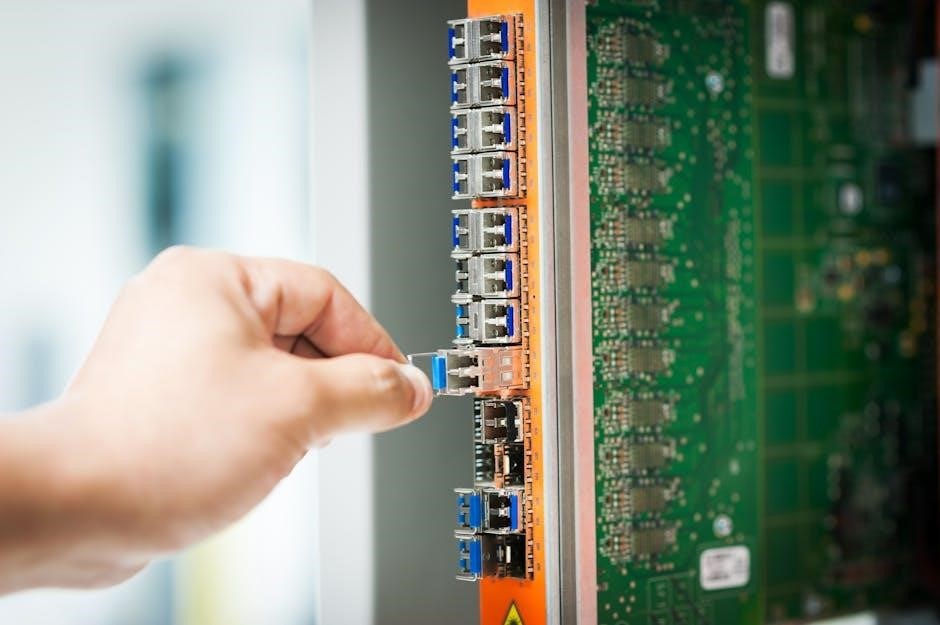
Understanding 4-Way Switches
A 4-way switch enables control of lights from multiple locations, typically used with two 3-way switches. It has four terminals, forming two traveler pairs, allowing current to flow through different paths based on switch position. Often used in staircases or hallways, it’s essential for controlling lights from more than two points.
2.1 Types of Switches: 2-Way, 3-Way, and 4-Way
Understanding the differences between 2-way, 3-way, and 4-way switches is crucial for wiring projects. A 2-way switch controls a light from one location, while a 3-way switch allows control from two points using traveler wires. A 4-way switch adds flexibility by enabling control from three or more locations, working between two 3-way switches. Each switch type has distinct terminal configurations, with 2-way having two terminals, 3-way having three (one common, two travelers), and 4-way having four terminals in two traveler pairs. Knowing their roles ensures proper circuit design and functionality.
2.2 Key Components of a 4-Way Switch
A 4-way switch features five terminals: one grounding terminal and four circuit terminals divided into two pairs of traveler terminals (T1 and T2). These terminals allow the switch to connect and control multiple lights from different locations. The grounding terminal ensures safety by providing a path for excess current. The traveler terminals facilitate the flow of electricity between switches, enabling the circuit to function correctly. Proper identification and connection of these terminals are essential for successful wiring, as misconnections can lead to circuit malfunctions.
2.3 How 4-Way Switches Differ from 3-Way Switches
A 4-way switch differs from a 3-way switch by having an additional traveler terminal, enabling control from four locations. It acts as an intermediary between two 3-way switches, allowing more flexible lighting control configurations. While a 3-way switch has three terminals, a 4-way switch has five, including a ground terminal. This extra terminal allows the 4-way switch to handle more complex wiring setups, making it ideal for larger circuits with multiple control points.
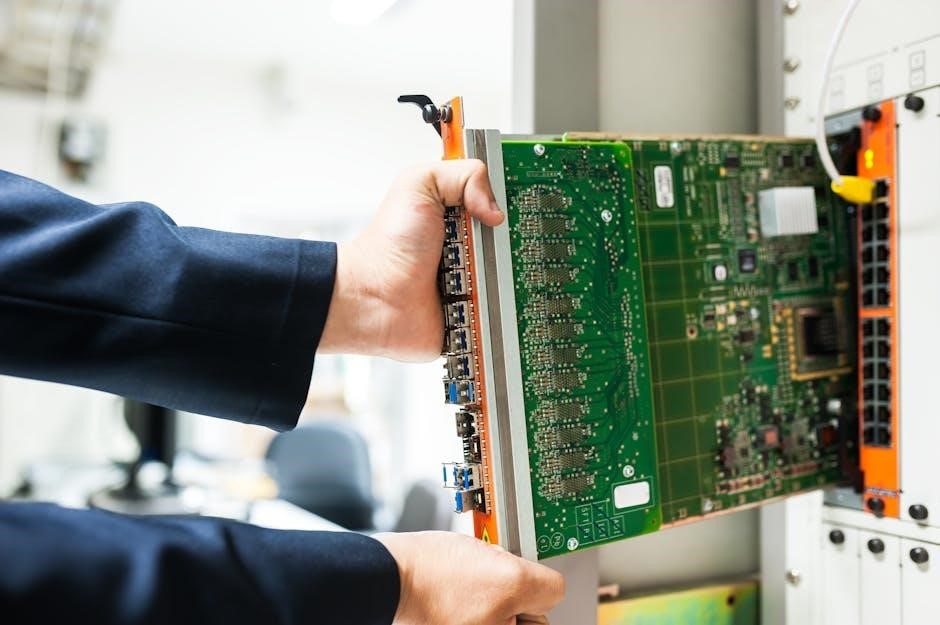
Wiring Configurations for 4-Way Switches
This section explores various wiring setups for 4-way switches, including power at the switch, power at the light, and configurations with multiple fixtures or dimmers.
3.1 Basic 4-Way Light Circuit with Power at the First Switch
In this configuration, power enters the first 3-way switch, connecting to its common terminal. Traveler wires link the switches, allowing control from multiple points. The neutral wire runs directly to the light fixture, ensuring proper circuit operation. The 4-way switch is placed between two 3-way switches, with traveler pairs connected to maintain continuity. This setup enables lights to be controlled from three or more locations efficiently and safely.
3.2 4-Way Circuit with Power at the Light Fixture
In this setup, the power source is located at the light fixture, with switches installed after it. A 2-wire cable connects the light to the first switch, while 3-wire cables link the switches together. The hot wire from the source is spliced to the white cable wire, running to the first 3-way switch. Traveler wires connect the switches, ensuring control from multiple locations. The white wire is marked as hot at each splice for clarity. This configuration allows for efficient control of lighting from three or more points without compromising safety or functionality.
3.3 4-Way Switch Wiring with Multiple Light Fixtures
Configuring a 4-way switch to control multiple light fixtures involves running 3-wire cables between switches and 2-wire cables to each fixture. The hot source is spliced at the first switch, connecting to the common terminal. Traveler wires link the switches, enabling control from multiple locations. Neutral wires are spliced through each box to ensure continuity. The common terminals on the final switches connect to the hot wires of the fixtures. This setup allows efficient control of multiple lights while maintaining electrical safety and proper circuit functionality.
3.4 4-Way Switch Configuration with Dimmers
Integrating dimmers into a 4-way circuit enhances lighting control. Three-wire cables connect the switches, with 2-wire cables leading to the light. A 3-way dimmer replaces standard switches, connecting its common terminal to the hot source. Traveler wires link the switches, and neutral wires splice through for continuity. The dimmer’s travelers must align with the 4-way switch’s terminals. Marking hot neutrals ensures safety. This setup allows adjustable brightness from multiple points, combining modern convenience with efficient circuit design for optimal performance and energy savings.
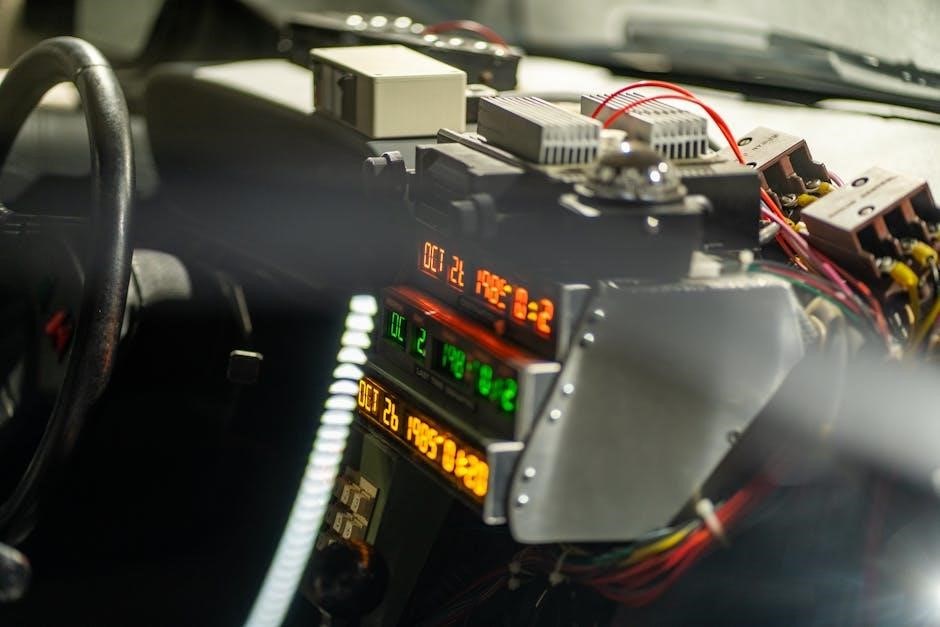
Step-by-Step Guide to Wiring a 4-Way Switch
Prepare components, connect traveler wires between switches, ensure neutral connections, and test continuity. Follow diagrams to avoid errors and ensure safe, proper circuit functionality for multiple light control.
4.1 Preparing the Wiring Components
Before starting, gather all necessary components, including 3-way and 4-way switches, appropriate wire gauges, and connectors. Ensure you have a multimeter and screwdrivers for testing and connections. Verify the wiring diagram corresponds to your setup, whether power is at the switch or light fixture. Identify traveler wires, common terminals, and neutral wires. Mark wires as needed to maintain clarity during installation. Proper preparation ensures a smooth and error-free wiring process for your 4-way switch configuration.
4.2 Connecting Traveler Wires Between Switches
When connecting traveler wires between switches in a 4-way configuration, ensure each pair of traveler terminals on the 4-way switch is connected to only one 3-way switch. This prevents mixing, which can disrupt the circuit. Use wire connectors for secure connections and mark wires for clarity. The traveler wires carry the electrical signal, while the common terminals on 3-way switches connect to the power source or light fixture. Always turn off the power and test continuity with a multimeter after wiring to ensure proper connections.
4.3 Ensuring Proper Neutral Wire Connections
Proper neutral wire connections are crucial for safe and efficient 4-way switch wiring. The neutral wire should be spliced through each box, connecting directly to the light fixture’s neutral terminal. Avoid connecting the neutral to any switch terminals, as this can cause improper circuit operation. Use wire connectors for secure splices and ensure all connections are tight. Mark the neutral wire clearly to prevent confusion. Always verify connections with a multimeter to ensure continuity and safety before restoring power to the circuit.
4.4 Testing the Circuit for Continuity
Testing the circuit for continuity ensures all connections are secure and functional. Use a multimeter to verify continuity between traveler wires and terminals. Turn off the power supply before testing. Check each switch’s terminals to confirm proper connections. Ensure the neutral wire is continuous from the source to the light fixture. If continuity is broken, inspect for loose wires or incorrect connections. Proper testing guarantees the circuit operates safely and efficiently, avoiding potential electrical hazards or malfunctions.

Common Wiring Mistakes and Solutions
Common mistakes include incorrect traveler wire connections and mixing traveler pairs. Forgetting to mark the hot neutral wire and improper grounding can cause circuit failures. Always double-check connections and use proper tools to ensure safety and functionality.
5.1 Incorrect Traveler Wire Connections
Incorrect traveler wire connections are a common mistake in 4-way switch wiring. Mixing up the traveler pairs or connecting them to the wrong terminals can disrupt the circuit, causing lights to malfunction or not work at all. To avoid this, ensure each pair of traveler wires is connected to the correct terminals on the 4-way switch and the corresponding 3-way switches; Always refer to a wiring diagram to verify the proper connections and test the circuit continuity before finalizing the setup.
5.2 Mixing Up Traveler Pairs on the 4-Way Switch
Mixing up traveler pairs on a 4-way switch is a common mistake that can prevent the circuit from functioning properly; Each pair of traveler terminals on the 4-way switch must be connected exclusively to one 3-way switch in the circuit. If the pairs are cross-connected, the lights may not turn on or may flicker unpredictably. To fix this, carefully label and match each traveler wire to its corresponding terminal, ensuring no cross-connections. Always refer to a wiring diagram to verify the correct configuration before testing the circuit for continuity.
5.3 Forgetting to Mark the Hot Neutral Wire
Forgetting to mark the hot neutral wire can lead to confusion and incorrect connections. In some configurations, the neutral wire may act as a hot wire, requiring clear identification. Use electrical tape or a marker to label the hot neutral wire at both ends to avoid mix-ups. This ensures proper connections and prevents potential short circuits or safety hazards. Always double-check the wiring diagram to confirm which wires should be marked as hot. Proper labeling is critical for maintaining clarity and ensuring the circuit functions as intended.
5.4 Improper Grounding of the Circuit
Improper grounding is a critical mistake that can lead to safety hazards and equipment damage. Always ensure the ground wire is securely connected to grounding terminals on all switches and boxes. Use a continuity tester to verify proper grounding. Metal boxes and switches require grounding for safety. Neglecting this step can result in electrical shocks or fires. Follow local electrical codes and double-check connections to avoid such risks. Proper grounding ensures the circuit operates safely and efficiently, protecting both people and devices.

Troubleshooting a 4-Way Switch Circuit
Identify common issues like incorrect traveler connections or defective switches. Use a multimeter to test continuity and ensure all wires are securely connected. Check for loose connections and verify proper grounding to resolve circuit failures effectively.
6.1 Identifying Common Issues in 4-Way Switches
Common issues with 4-way switches often stem from incorrect wiring, such as mixed traveler pairs or improper neutral connections. Defective switches or loose terminals can also cause malfunctions. Additionally, overloading the circuit or improper grounding may lead to failure. Identifying these issues requires careful inspection of connections and testing with a multimeter. Ensuring all wires are securely fastened and correctly routed is crucial for reliable operation. Regular maintenance and adherence to wiring diagrams can prevent such problems.
6.2 Using a Multimeter for Testing Continuity
A multimeter is essential for verifying continuity in 4-way switch circuits. Set the multimeter to the Ohms function and test between traveler terminals. Place one probe on a terminal in one traveler pair and the other on a terminal in the second pair. Flip the switch and check for continuity changes. If there’s no change or constant continuity, the switch may be faulty. This method ensures proper wiring and switch functionality, helping to diagnose issues quickly and accurately.
6.3 Replacing a Defective 4-Way Switch
Replacing a defective 4-way switch requires careful attention to wiring configuration. Turn off the power and disconnect the switch from the circuit. Remove the switch and compare its terminals with the new one. Connect the traveler wires to the correct pairs, ensuring no mixing of terminals. Reattach the switch to the box and restore power. Test the circuit to ensure all lights function correctly from every switch location. Proper replacement ensures reliable operation and prevents future electrical issues.
6.4 Checking for Loose Connections
Loose connections are a common cause of 4-way switch circuit failures. Turn off the power and inspect all wire terminals. Use a screwdriver to tighten any loose screws. Check wire nuts or connectors for secure fastening. Ensure traveler wires are properly paired and not mixed. Verify neutral and ground connections are intact. After tightening, test the circuit to confirm all lights function correctly. Regular checks prevent electrical issues and ensure safe, reliable operation of the 4-way switch system.
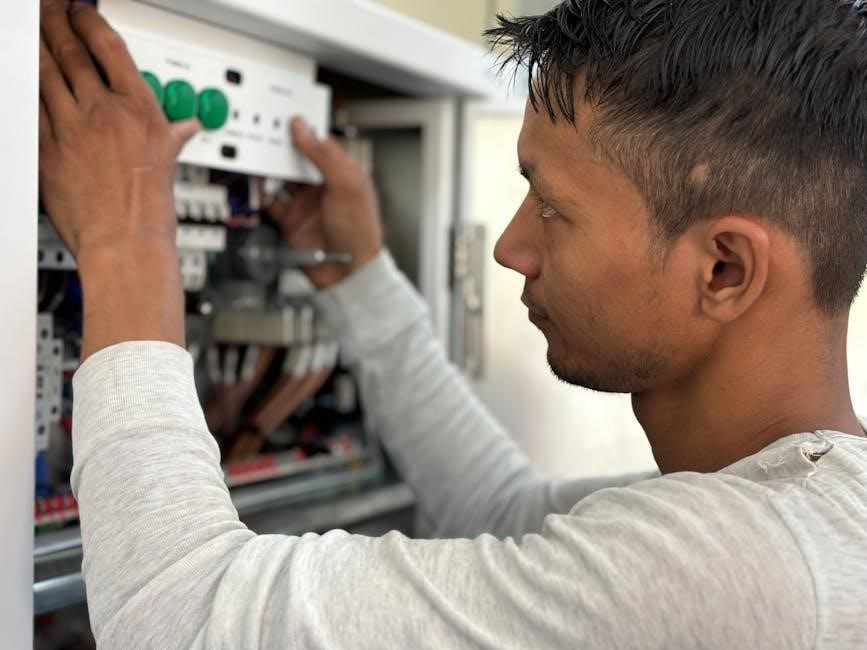
Safety Tips for Working with Electrical Wiring
Always turn off the power supply before starting work. Use proper tools and protective gear to prevent injuries. Follow local electrical codes and avoid overloaded circuits for safety.
7.1 Turning Off the Power Supply
Always disconnect the power supply before starting any electrical work. Ensure all circuits are de-energized using the main electrical panel. Verify the absence of voltage with a multimeter for safety.
7.2 Using Proper Tools and Protective Gear
Use insulated tools and wear protective gear, including gloves and safety glasses, to prevent electrical shocks and injuries. Ensure tools are suitable for the task, and keep them in good condition for reliable performance and safety.
7.3 Understanding Local Electrical Codes
Familiarize yourself with local electrical codes to ensure compliance. These codes dictate wiring standards, safety measures, and permitted practices. Adhering to them prevents legal issues and ensures your 4-way switch installation is safe and durable.
7.4 Avoiding Overloaded Circuits
Avoiding overloaded circuits is crucial for safety and system reliability. Overloading can cause fires or electrical failures. Ensure your circuit is rated for the total power load. Distribute the load evenly, use appropriate wire gauges, and avoid excessive connections. If necessary, install additional circuits to handle higher demands. Always consult a licensed electrician if unsure about capacity limits to prevent hazards and ensure compliance with safety standards.

Advanced 4-Way Switch Configurations
Explore advanced setups like controlling lights from four locations, integrating smart switches, and wiring multiple fixtures. These configurations enhance functionality and require precise planning for optimal performance.
8.1 Controlling Lights from Four Different Locations
Controlling lights from four locations involves using two 3-way switches and two 4-way switches. The traveler wires connect each switch, allowing seamless control. The hot source connects to the first 3-way switch, while the light fixture links to the last. Neutral wires are spliced through each box to maintain continuity. This setup ensures flexibility and convenience, ideal for large spaces like halls or staircases. Proper wiring and careful planning are crucial for functionality.
8.2 Integrating Dimmers into a 4-Way Circuit
A 3-way dimmer can replace standard 3-way switches in a 4-way circuit to enable dimming. The dimmer has four wires: common, two travelers, and a ground. Connect the common wire to the hot source, and the travelers to the 4-way switch. Neutral wires must be spliced through each box to maintain continuity. Ensure the white wire is marked as hot if used for traveler connections. Testing with a multimeter can verify proper circuit functionality before final installation.
8.3 Using Smart Switches in a 4-Way Setup
Smart switches can be integrated into a 4-way circuit for advanced control via smartphones or voice assistants. These switches require a neutral wire connection for power. The common terminal connects to the hot source, and travelers link to other switches. Neutral wires are spliced through each box. Ensure compatibility with existing wiring and devices. Testing with a multimeter is recommended to confirm proper connections. This setup allows remote dimming and scheduling, enhancing convenience and energy efficiency without compromising the circuit’s functionality.
8.4 Wiring for Multiple Light Fixtures with 4-Way Switches
When wiring multiple light fixtures with 4-way switches, each light should be connected in parallel. Start by connecting power to the first 3-way switch, then run traveler wires to the 4-way switch, and finally to the second 3-way switch. Connect the lights in parallel after the second 3-way switch, ensuring each light has its own neutral connection. The ground wire should be connected to each junction box and light fixture for safety. Use the same traveler wires to carry the switched power to all lights. Ensure compatibility with dimmers or smart switches, which may require a neutral wire. Test the circuit thoroughly to confirm all lights function correctly from all switch locations.
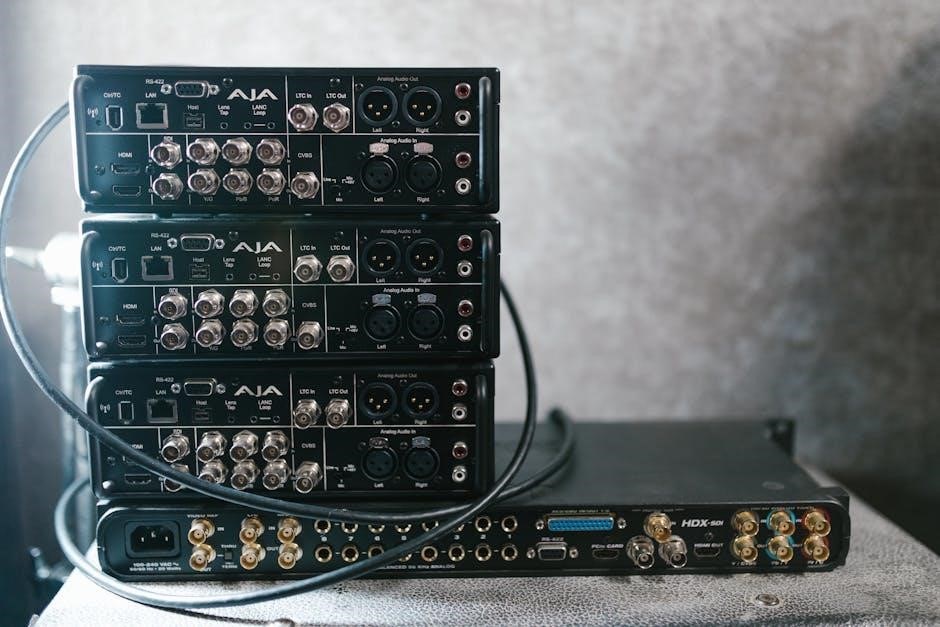
Downloading 4-Way Switch Wiring Diagrams in PDF
4-way switch wiring diagrams are available as free PDF downloads, offering detailed visual guides and step-by-step instructions for various lighting configurations and control setups.
9.1 Sources for Free 4-Way Switch Wiring Diagrams
Free 4-way switch wiring diagrams are available from reputable sources like do-it-yourself-help.com and other electrical resource websites. These diagrams are often provided in PDF format, making them easy to download and print for reference. They include detailed illustrations and step-by-step guides for various wiring configurations, ensuring clarity for both beginners and experienced electricians. Many websites also offer troubleshooting tips and advanced setups, such as controlling lights from multiple locations or integrating dimmers. These resources are invaluable for safe and successful DIY electrical projects.
9.2 How to Read and Interpret Wiring Diagrams
Understanding wiring diagrams requires familiarity with electrical symbols and color coding. Each symbol represents a component, such as switches, lights, or wires. Color coding indicates wire functions: black for hot wires, white for neutral, and copper for ground. Diagrams show connections between components, helping trace circuits from power sources to devices. Start by identifying the power source and follow connections to switches and lights. Proper interpretation ensures safe and correct wiring, avoiding errors that could lead to electrical hazards or system malfunctions.
9.3 Printing and Using PDF Diagrams for Projects
Download and print 4-way switch wiring diagrams in PDF format for clear guidance. Use high-quality printers to ensure details are visible. Laminate the diagrams for durability. Follow the step-by-step instructions and color-coded wires. Refer to the diagrams during installation to avoid mistakes. Highlight or mark completed steps for better organization. Keep the diagrams in a binder or folder for easy access. Ensure all safety precautions are followed while working with electrical systems. These PDF guides are essential for successful project execution and troubleshooting.
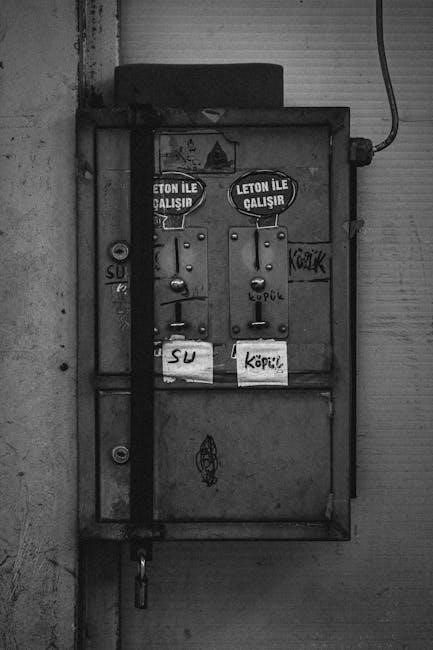
Best Practices for 4-Way Switch Installation
Plan the circuit layout carefully, ensuring correct wire colors for safety. Use proper splicing techniques and label wires for future maintenance to ensure reliability and ease of troubleshooting.
10.1 Planning the Circuit Layout
Planning the circuit layout is crucial for successful 4-way switch installation. Start by identifying the locations of switches, lights, and power sources. Use a wiring diagram to map connections, ensuring all components are linked correctly. Determine the type of cables needed and their lengths. Consider the flow of power from the source to switches and finally to the lights. Proper planning prevents errors and ensures safe, efficient control of lighting from multiple locations. Always double-check the layout before starting the installation;
10.2 Using the Correct Wire Colors for Safety
Using the correct wire colors ensures safety and compliance with electrical standards. Black wires are “hot” and carry power, while white wires are neutral. Red wires are used for travelers in 4-way circuits. Copper wires are grounding. Always follow color coding to avoid dangerous connections. Misidentifying wires can lead to electrical hazards or system malfunctions. Proper wire color identification ensures safe and efficient circuit operation, adhering to standard electrical practices. This step is vital for maintaining safety and reliability in your wiring project.
10.3 Ensuring Proper Wire Splicing Techniques
Proper wire splicing ensures secure and reliable electrical connections. Use wire nuts or connectors rated for your environment to prevent loose or corroded connections. Always twist wires tightly before securing them. For added protection, wrap spliced areas with electrical tape. Ensure splices are accessible and not hidden in walls or ceilings. Improper splicing can lead to electrical failures or fire hazards. Testing connections with a multimeter can verify their integrity. Properly executed splices are essential for long-term circuit reliability and safety.
10.4 Labeling Wires for Future Maintenance
Labeling wires is crucial for future maintenance and troubleshooting. Use color-coded stickers or markers to identify live, neutral, and ground wires. Clearly mark each wire’s purpose, such as “Power to Light” or “Traveler Wire.” Consider labeling at both ends of the wire for easy identification. This practice ensures anyone working on the circuit can understand the wiring without confusion. Proper labeling also enhances safety and reduces the risk of electrical errors during repairs or upgrades. Invest in durable labels that withstand environmental conditions.
Understanding 4-way switch wiring diagrams is essential for safe and efficient electrical installations. Proper connections ensure reliable control of lighting from multiple locations, enhancing safety and functionality.
11.1 Summary of Key Points
Understanding 4-way switch wiring diagrams is crucial for controlling lights from multiple locations. Key points include proper connections, traveler wires, and neutral wire management. Safety tips like turning off power and using correct tools are essential. Troubleshooting involves checking traveler pairs and neutral connections. Best practices include labeling wires and ensuring proper grounding. Using diagrams and multimeters aids in successful installations. Proper planning and adherence to local codes ensure reliability and safety in 4-way switch circuits.
11.2 Final Tips for Successful 4-Way Switch Wiring
Plan your circuit layout carefully and use diagrams to guide connections. Always turn off power before starting work. Test each step with a multimeter to ensure continuity. Label wires clearly for future maintenance. Avoid mixing traveler pairs on 4-way switches. Double-check neutral and ground connections for safety. Consult local electrical codes and use proper tools. If unsure, seek professional help. Proper installation ensures reliable performance and safety in controlling lights from multiple locations with 4-way switches.